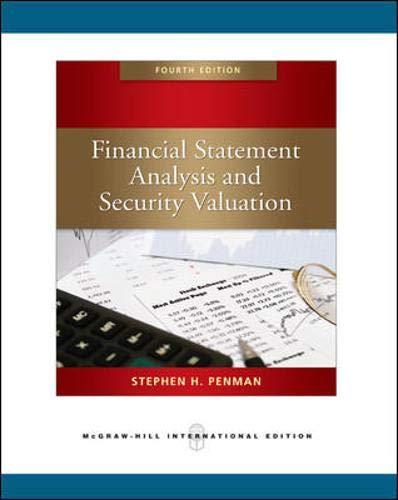New businesses take time to get established, and the new Internet firms of the late 1990s were
Question:
New businesses take time to get established, and the new Internet firms of the late 1990s were no exception. Internet portal firms and e-commerce firms traded at high multiples of sales on the promise of large profits, but most of them were generating losses from their sales In statements to the press, these firms maintained that their "business model" required them to incur substantial losses in order to generate future profits. Investments were re- quired in infrastructure. Considerable expenditure was required for advertising and promo- tion to establish a customer base and to create brand recognition. So these firms appealed to investors to ignore the bottom line and focus rather on their ability to generate revenues. Accordingly, the price-to-sales ratio became the typical multiplier that investors referred to. And analysts referred to other indicators like "hit rates" and "page views" (on Web sites) to assess the price-to-sales ratio. In arguing that the losses they were reporting were not indicative of the value in their business model, Internet entrepreneurs argued that the GAAP accounting they were re- quired to use was of low quality. But clearly investors were left with the question of whether these firms would actually become profitable in the end and whether the size of the profits would justify the high stock prices at which these firms traded. Rather than the crude indi- cators like hit rates, they looked for more substantial financial analysis. ONLINE TRADING FIRMS During 1999 there was a dramatic shift by investors to online stock trading on the Internet. E*Trade, TD Waterhouse, National Discount Brokers, and others battled with Charles Schwab, the traditional discount broker, and with each other for market share. Morgan Stanley Dean Witter, a more traditional broker, offered online trading through its Discover brokerage. Merrill Lynch, after initially indicating that it might shun the online business, entered the fray in late 1999 with a $29.95 per-trade fee. Figures as of September 1999 for some of the firms selling online trading services follow. Earnings and sales are rolling 12-month numbers to June 30, 1999 (M = millions, B = billions): Sales EPS Value Market P/E Ratio Price-to- Price-to- Book Ratio Sales Ratio E+Trade $464M TD Waterhouse 896M 0.25 -0.23 $ 5.758 1 5.130 47 5.5 124 2.6 5.7 National Discount Brokers 250M 1.28 458.6M 20 2.6 1.8. Ameritrade 274M 0.15 3.288 119 9.2 12.0 Charles Schwab 3.3618 4.11 27.68 56 14.4 8.2 In the fall of 1999, these firms began an advertising war. In the industry, market share is referred to as "share of voice." Customers are sticky, it is said: They tend to stay with the same brokerage, so attracting them-and building a brand name to attract them-is seen as the driver of ultimate success. Schwab, with a large discount brokerage business prior to the advent of online trading. led with a 25 percent share of voice on the Internet. But in early 1999, E Trade increased its share to 14 percent with what was judged a very successful advertising campaign on prime-time TV shows such as Ally McBeal and E.R. and on the Super Bowl, the most ex- pensive advertising time of all. Others imitated, so that by the end of 1999 it was said that these finns had committed to a total of $1.5 billion in advertising over the subsequent 18 months. To give a sense of perspective, this amount is roughly equal to the annual ad- vertising budget of Coca-Cola. Estimates varied, but industry analysts maintained that in a market saturated with competitors, it takes $400 to $500 in advertising and inducements to sign up each new customer, with repeat advertising of $100 per customer to retain them and maintain the brand. E*TRADE ExTrade was one of the first online trading firms to challenge Schwab and the traditional brokers. It spent $322 million on sales marketing for its fiscal year ended September 30, 1999, increasing the number of trading accounts by 1 million to 1.55 million and produc ing revenues of $657 million. Based on its marketing expenses for the first quarter of fiscal 2000, its annual advertising budget was running at $450 million. Exhibit 16.1 presents summary financial statements for E Trade Group, the firm that runs E Trade, for the September 1999 fiscal year. A. Why are the earnings reported by start-up firms considered to be a "low quality" number? B. Why should investors be wary of price-to-sales ratios? Why should they be skeptical about bit rates and page views on Web sites? C. Develop an analysis that tests E-Trade's business model with the marketing information in the case. D. E Trade Group traded at $25 per share at the end of September 1999, giving it a price- to-sales ratio of 10.5. Given your analysis in part (C), was the firm appropriately priced at the time? E. What other strategies might E-Trade pursue to add value? F. By early 2000, the number of online brokerage firms had exploded to about 140 and competition was fierce. The industry needed consolidation, it was said, to deal with the glut in capacity. Should E-Trade consider acquisitions to consolidate the dominant position it holds and compete more effectively with Charles Schwab? Stock market val- ues for the larger online firms in the preceding table were such as to value each customer account at about $3,000 each.
Step by Step Answer:

Financial Statement Analysis And Security Valuation
ISBN: 9780071267809
4th International Edition
Authors: Penman-Stephen-H, Steven Penman





